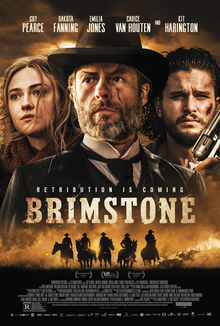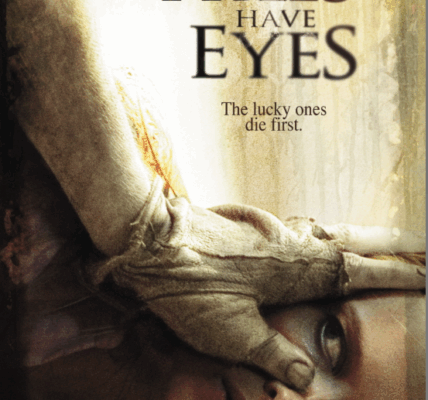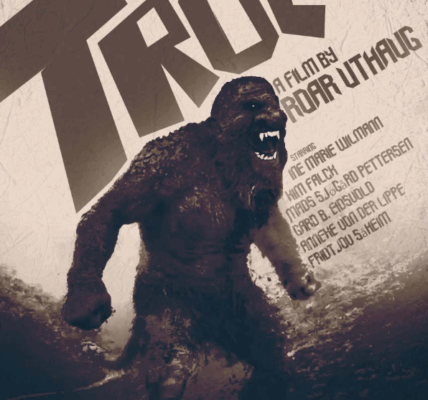Movie Overview
- Title: Brimstone (2016)
- Release Date: First released in the Netherlands on 12 January 2017; U.S. limited / video-on-demand on 10 March 2017.
- Genre: Psychological Western / Thriller / Drama
- Director: Martin Koolhoven
- Main Cast:
• Dakota Fanning as Elizabeth “Liz” Brundy
• Guy Pearce as “The Reverend” (a sinister preacher)
• Emilia Jones as Joanna
• Kit Harington as Samuel
• Carice van Houten as Anna - Where to Watch: The film is available in many territories via digital platforms / video-on-demand (e.g. Fandango at Home in the U.S.) and DVD/Blu-ray.
1. Plot Summary
Brimstone is set predominantly in the American “Old West” frontier (though there are desert and mining town settings, etc.), and is structured in four acts: Revelation, Exodus, Genesis, and Retribution. However, these are presented out of chronological order, giving the audience pieces of the story in a non-linear fashion.
The central character is Liz (mute, communicates by sign language), living a life as a midwife with her husband Eli, and their children. Her life is disrupted when a new, vengeful preacher nicknamed The Reverend arrives in town, and accusations and horrors begin, forcing Liz into flight and into remembering / re-experiencing a traumatic past.
Through the acts, we see key junctures of Liz/Joanna’s life—how her childhood and upbringing under her father (who turns out to be the Reverend), time in a brothel, betrayal, violence, abuse, and trauma, shape who she becomes. The “wrongly accused crime” aspect (accused of causing a baby’s death, among other things) triggers the Reverend’s persecution. Over time, Liz becomes fugitive, trying to protect herself and her children from the Reverend’s cruelty, while also dealing with identity, loss, and survival.
In the final act, Retribution, the strands converge: Liz fights back, confronts sins of her past, and the consequences of her fugitive status catch up with her in tragic and powerful ways. Her motives, choices, and sacrifices are revealed in full.
2. Notable Elements
What stands out in Brimstone — both what makes it powerful, and what makes it difficult.
Standouts
- Dakota Fanning’s Performance as Liz: Fanning gives a quietly intense portrayal. Because her character is mute, much has to be conveyed through body language, facial expressions, eyes. She embodies a mix of fear, resilience, trauma, and determination. Critics often cite her as anchoring the film’s emotional power.
- Guy Pearce as The Reverend: He is chilling, menacing in a low-key way, but his fanaticism and cruelty make him one of the film’s most memorable antagonists. He often seems to embody hypocrisy, abject evil cloaked in religious righteousness.
- Nonlinear Narrative / Four Acts Structure: The way the story is told in out-of-order chapters allows suspense, mystery, and revelations to land with more weight. Moments that occur later in Liz’s life have echoes and roots in earlier trauma; this structure demands attention and rewards remembering details.
- Visual & Cinematic Mood: The cinematography (by Rogier Stoffers) delivers a harsh, dusty, often brutal landscape: deserts, frontier farms, churches, mining towns, brothels. The style is gritty, sometimes stark, often bleak. The film does not shy away from showing cruelty, but also crafts strong images (silhouettes, faces, light, shadows) that linger.
- Violence & Themes of Oppression: The film’s violence is brutal, and it explores deeply unpleasant behavior (abuse, rape, misogyny, religious extremism). There is a moral darkness that the film examines rather than ignoring. It often forces the viewer to confront how power is abused, and how victims cope.
What’s More Problematic / Less Strong
- Length & Pacing: At ~148 minutes, the film is long. Some reviewers note that the intensity is hard to sustain, and pacing drops in some segments. The non-linear structure helps mystery, but also means some parts drag or seem repetitive.
- Emotional Toll / Disturbing Content: The film is very dark. For many viewers, the brutality may feel overwhelming, its relentlessness exhausting. Some scenes are hard to sit through. This is not a film for the faint of heart.
- Ambiguity / Clarity in Some Twists: Some reviewers feel that certain narrative leaps (especially given the non-chronology) stretch credulity, or that some character motivations are less explored than they could have been. Some plot resolutions in the final act are criticized as being less convincing.
3. Themes & Messages
Here are the main thematic threads, and how they resonate:
- Survival & Resistance: At its core, Brimstone is about enduring horror, refusing to be broken by evil, and the cost of survival. Liz/Joanna survives abuses, terrors, betrayals; her resistance is quiet but persistent.
- Identity & Voice: Because Liz is mute, her voice is nonverbal for much of the film, which matters both literally and metaphorically. There’s also identity shifting (she assumes others’ identity in some contexts), hiding, altering what one is to survive. Communication (or lack thereof), signs, language, and power are central.
- Hypocrisy & Religious Fanaticism: The Reverend represents religious power used as control, torture, and abuse. The film critiques how religious authority, when coupled with fanaticism, can justify cruelty.
- Gendered Violence, Oppression & Power Imbalance: Women (and girls) in this film are subject to systemic violence, exploitation, cruelty. The story shows how gender, vulnerability, and institutional power intersect in tragic ways.
- Justice, Guilt, Redemption & Retribution: There is a sense of wrongs that have to be confronted, of past sins returning, of revenge vs forgiveness. The acts’ ordering (especially “Retribution”) shows that the past cannot always be outrun.
- Trauma & Memory: Nonlinear storytelling highlights that trauma is non-linear: memories, repercussions, triggers shape the present. The past is never gone; it shapes who someone is.
These themes are not “holiday” in a festive or traditional sense, but deeply human: suffering, endurance, sacrifice, truth vs evil, hope (or refusal) in darkness. Thus they resonate, perhaps more for reflective or solemn seasons, or audiences willing to think deeply.
4. Personal Impressions
Here are what I felt, both positive and what I found difficult, from watching Brimstone.
What I Admired
- The film’s courage: it does not make its heroine’s suffering easy; nor does it allow easy forgiveness or closure until the end. There is integrity in showing how horrific injustice can be, how persistent evil is—and how someone still might fight back.
- The performances are very strong—especially Dakota Fanning and Guy Pearce. Their characters are well drawn, and even small moments (a look, a sign, a silent reaction) carry weight.
- The visual world is immersive and harsh, which suits the story’s moral seriousness. The frontier, the mines, tents, brothels, church pulpits etc all feel like elements of a living (though cruel) world.
- The structure—nonlinear, chaptered—while a risk, often works well in maintaining tension, mystery, and making the audience piece together Liz’s past. When the narrative reveals a new act (Genesis, Exodus etc), the emotional resonance is increased because one is seeing cause and effect non-sequentially.
What I Found More Challenging
- It is emotionally draining. A viewer has to be willing to sit through significant cruelty. For me, some scenes’ accumulation of suffering felt more punishing than illuminating. The intensity, especially of gendered violence, is heavy.
- Occasionally the non-linear jumps feel confusing. Some revelations come late enough that you realize earlier scenes had different meaning; while that is partly intended, sometimes the shifts make emotional pacing uneven.
- The ending, while powerful, has some parts that felt a bit cinematic-convenient or less believable (e.g. certain escape sequences or confrontations). Suspension of disbelief becomes strained in places.
- Because the film focuses so much on Liz’s suffering and the pursuit by the Reverend, some secondary characters feel less rounded. Their roles are often symbolic or functional rather than fully fleshed out.
5. Audience Recommendations
Who this film is especially good for, and who might prefer to skip or be cautious.
Would Likely Enjoy
- Viewers who appreciate dark, morally intense Westerns or frontier stories that interrogate power, cruelty, and resistance, rather than romanticised or simplistic Westerns.
- Fans of adult dramas, psychological thrillers, films that explore trauma, identity, and survival.
- People who like non-linear storytelling, stories told as puzzles where revelation comes over time, not always in straightforward order.
- Audiences who can handle grim content, violence, injustice, moral ambiguity, and who don’t expect light entertainment.
- Those who appreciate strong performances, especially in difficult roles, and cinematic visuals.
Might Be Less Suited For
- Viewers who are sensitive to depictions of sexual violence, abuse, cruelty toward women and children.
- If you prefer lighter tone, more hopeful escapism, or less morally punishing narratives.
- Those who prefer very linear, straightforward storytelling with less ambiguity in character motives or fewer jumps in time.
6. Conclusions & Rating
In conclusion, Brimstone is a powerful, haunting, morally uncompromising Western that surprises in its ambition, its emotional force, and its intense examination of cruelty and survival. It’s not an easy film—but it’s one of those movies whose discomfort is part of its point. It demands empathy, endurance, and reflection.
Final Recommendation: I recommend Brimstone for those who want cinema to challenge them, to present not just adventure but the shadow side of human belief, of power, of survival. It’s a film that lingers; you’ll think about it after the credits roll. If you’re in the mood for something heavy, dark, and beautifully made, this is a film worth seeing.
Star Rating: ★★★★☆ (4 out of 5 stars) — strong, rare, deeply felt, but the intensity and some flaws keep it from a perfect score.




